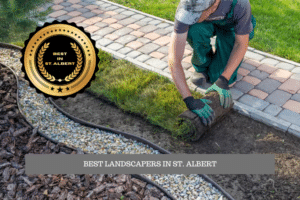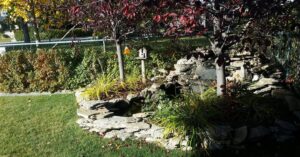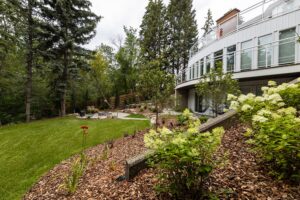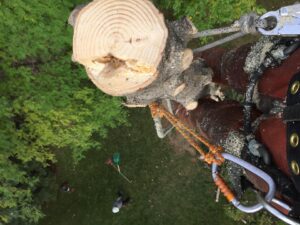Nerw Blog was submitted by Earthworm Landscape Design Co in Edmonton.

With increasing pressures on water availability and lingering thoughts of drought, it is important to consider landscape practices that will not increase the demand for water and a way to keep rainwater in our yards for use in our gardens, be they ornamental or vegetable. Many methods can be employed. As professional landscape designers in Edmonton, we will share information about xeriscaping, watering habits, and mulching as a few water-saving methods to consider.
Xeriscaping
The word xeriscape in latin means “dry view” or “dry landscape”. There is an excellent book written by Canadian author Sara Williams called “Creating the Prairie Xeriscape’. The main principles of xeriscaping are designing for water conservation, improving soil, reducing lawn areas, efficient irrigation, mulching and appropriate plant selection. It does not need to look like a desert to fulfill the design principles. There are more plants than you may think that are suitable for this application. Some of our favourites include:
| Trees | Shrubs | Evergreens | Perennials |
| Amur Maple (Acer ginnala)
Flowering Crabapple (Malus spp.) Burr Oak (Quercus macrocarpa) Showy Mountain Ash (Sorbus decora) Ivory Silk Tree Lilac (Syringa reticulata ‘Ivory Silk’) |
Saskatoon (Amelanchier alnifolia)
Red Osier Dogwood (Cornus sericea) Potentilla (Potentilla spp.) Dwarf Korean Lilac (Syringa meyeri) Mockorange (Philadelphus lewisii) |
Upright Juniper (Juniperus scopulorum)
Spreading Juniper (Juniperus horizontalis) Dwarf Blue Globe Spruce (Picea pungens ‘Glauca Globosa’) Weeping Norway Spruce (Picea abies ‘Pendula’) Chalet Swiss Stone Pine (Pinus cembra ‘Chalet’) |
Yarrow (Achillea spp.)
Karl Foerster Reed Grass (Calamagrostis spp.) Globe Thistle (Echinops ritro) Dalily (Hemerocallis spp.) Sedum (Sedum spp.) |
Need more advice? Contact Earthworm Landscape Design Co in Edmonton!
Watering Habits
In most new neighbourhoods, considerations for water conservation are actually becoming requirements. Homeowners are encouraged to think of how they can capture and reuse water in their yards. One of the easiest ways to capture water is a rain barrel at every downspout. This water can then be used freely as needed to water the garden, lessening the reliance on city water. It may seem cumbersome to lug watering cans, so consider placing your rain barrel higher, say 24”, off the ground. This will allow for ease of filling your watering can, but you can also use gravity for soaker hoses or small drip irrigation systems.
New plantings
Let’s discuss new plantings for a moment. Whenever someone plants a new plant, I always recommend that you soak it in a bucket before planting. Then, afterwards, you water only once the top 3-4” dry out. This will encourage the root system of the plant to explore the surrounding soil, develop a strong root system and not be reliant on your application of water. Strong root systems also have a great ability to capture large amounts of water once established. I live on an acreage, and this is the method I employ. Our water is trucked in, so there is no way that I am going to “baby” any new plantings. It truly builds a resilient plant. The only plants I water are in pots or in the greenhouse, all using captured rainwater or snowmelt. Now, let’s look at our lawns.
Lawns
The grass is always greener in the yard where the sprinkler runs. Wait, that’s not how the saying goes…Let’s take a moment to think about our green grass. Lawns require a lot of water to remain lush and green, not to mention fertilizer. Consider an alternative such as clover or reducing the amount of grass that you have. You could also use rainwater to water your lawn with a simple irrigation system.
Mulching
Mulch is as simple as a layer of material that covers the ground. Mulch holds moisture and also keeps the roots of the plants cool. This reduces the need for extra water. Now, not every mulch is created equally. Rock mulch will actually increase the need for water and keep your plants hot. The soil heats quickly, and therefore, you have more evaporation.
You may be thinking, so…what is the best type to use? Bark mulch. It comes in many forms, cedar, pine, spruce, etc. A thick layer of clean straw or fall leaves is also a wonderful mulch material. They all perform relatively the same in which when they are moist, they stay moist for a long time. Be sure not to bury the trunks of trees and shrubs or the crowns of your perennials so they don’t rot with this extra moisture. Happy plants all around.
As a landscape design company in Edmonton, one question we often get is, what about landscape fabric? The simple answer is, if there are plants involved, say no to landscape fabric. You want the soil surface to be as permeable as possible, and you want to avoid any runoff. Areas that are suitable for landscape fabric are spots where there are no plants; you intend on simply covering the ground with rock (prevents mixing of rock and soil) or under a deck or structure to prevent weeds. Those are the only places I recommend.
We hope that with this information, you will consider some or all of these practices when you tackle your next landscape project.









